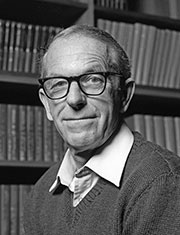 Fred Sanger (1918 – 2013)
Fred Sanger (1918 – 2013)
Fred Sanger has the distinction of being the first scientist to be awarded the Nobel Prize for Chemistry twice: in 1958 and 1980.
Fred was born on August 13, 1918 in Rendcombe in Gloucestershire. His father was a GP and his mother was the daughter of a wealthy cotton manufacturer. He attended the Downs School, a preparatory school run by Quakers and then went to the Bryanston School in Dorset at the age of 14. In 1936 he became an undergraduate at St. John’s College, Cambridge. He originally intended to study medicine, like his father, but decided he would be better suited to a career in science. He became especially interested in Biochemistry after his arrival at Cambridge. After graduating in 1939 he was supervised by Albert Neuberger in the University of Cambridge’s Biochemistry Department where he began his PhD working on protein metabolism. As he was brought up a Quaker he became a conscientious objector during World War II, and was allowed to carry on with his research and finish his PhD.
In 1943 he started postdoctoral research with Professor Charles Chibnall the newly appointed Head of the Biochemistry Department. It was Chibnall who suggested that Fred should look at the end groups of proteins: the amino acids at the end of the polypeptide chain. The hormone, insulin, was chosen for the work, as it was a protein that you could buy in pure form. For several years, Fred worked on developing methods to determine the order of the amino acids of insulin, finally revealing the entire sequence of the 51 amino acids and showing how they linked together.
Fred was awarded his first Nobel Prize for Chemistry in 1958, for developing the methods for amino acid sequencing. This involved separating the different fragments of a protein on filter paper and then moving them with an electrical current according to their electric charge. This created a distinct pattern on the paper which Fred called a ‘fingerprint’. The information about these fragments then had to be reconstructed in the correct order, to give the sequence or ‘chemical structure’.
At the time of the Nobel Prize, Fred, who was funded by the Medical Research Council (MRC), was already in discussion with the neighbouring MRC Unit for Research on the Molecular Structure of Biological Systems, lead by Max Perutz, to join them in plans for a new laboratory. In 1962, the MRC laboratory of Molecular Biology opened, and Fred became the Head of the Protein and Nucleic Acid Chemistry Division.
Following on from the work on proteins, Fred began to look at the sequencing of nucleic acids. This work involved developing a technique to determine the exact sequence of the building blocks in DNA, called bases. Using a virus as an example, Fred developed the “dideoxy” technique for DNA sequencing, which he published in 1975. The method allowed stretches of 500-800 bases to be read at a time, and the virus became the first fully sequenced genome.
It was this work on DNA Sequencing that led to Fred’s second Nobel Prize for Chemistry, received in 1980 jointly with Paul Berg (Stanford University) and Walter Gilbert (Harvard University), “for their contributions concerning the determination of base sequences in nucleic acids”. This method would shape the way that genomics and biomedicine were explored and was key to the Human Genome Project, the international collaboration to identify all the approximately 20,000-25,000 genes in human DNA.
After the Second Nobel Prize, Fred continued to work until 1983 when he retired at the age of 65 to spend time gardening and “messing about in boats”.
His contribution to the science of genomics saw him being asked if he agreed to the naming of an institute after him. He agreed, but is said to have warned them “it had better be good”. Fred officially opened The Sanger Centre (now The Sanger Institute) on 4 October 1993.
Fred was made a Fellow of the Royal Society in 1954, Commander of the Order of the British Empire in 1963 and the Order of Merit in 1986. He declined a knighthood as he preferred not to be called ‘Sir’.
References
- Wellcome Trust Sanger Institute
- Hargittai, I. Interview: Frederick Sanger. The Chemical intelligencer: 6-11 (1999)
- “Frederick Sanger – Autobiography“. Nobelprize.org.